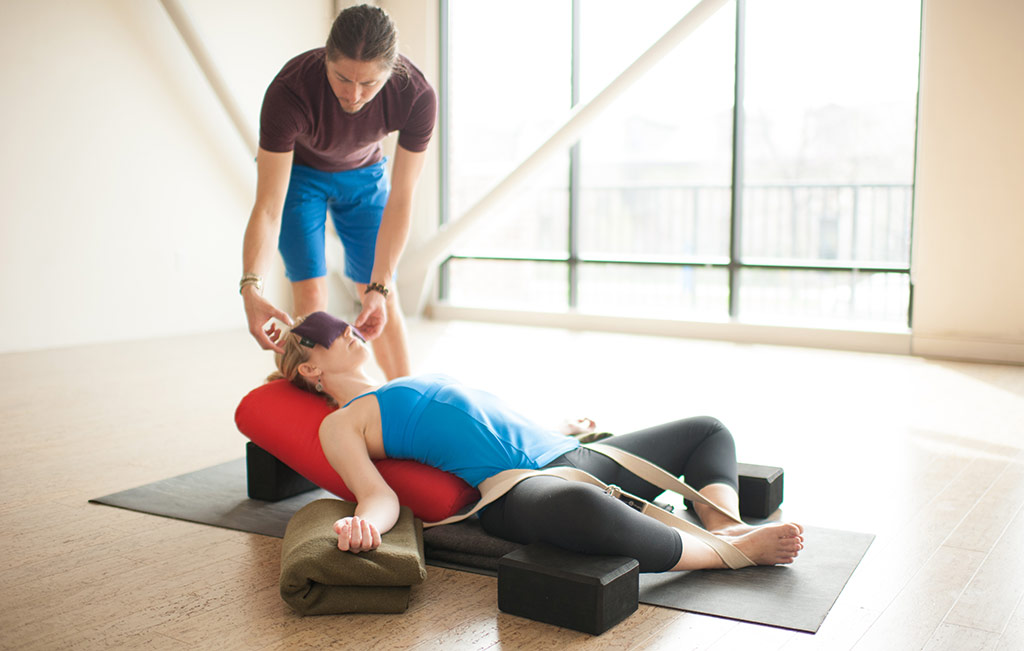
Here’s the third part in a series about yoga for insomnia. Here are Parts One and Two.
Roger Cole, Ph.D. in sleep physiology and longtime Iyengar Yoga teacher, lists four things that must occur for relaxation to happen (not necessarily in this order):
- Relax the breath.
- Relax the body.
- Relax the nervous system.
- Relax the brain.
All these processes are interdependent; when you relax one component all the others follow suit.
Before beginning any of the following practices it can be helpful to sit quietly in a comfortable position for at least a few minutes. Turn your attention to your breathing, aligning your awareness to an area of the body where the breath feels clear. During the following practices it is helpful to anchor awareness to whatever physical sensations you feel.
Relax the Breath
Knowing how breathing affects the nervous system is essential to allowing the body to relax. Breathing is the one thing all living beings have in common; it carries the essence of life. It is so important that it is the only physiological function that we can directly control.
The breathing rhythm interacts with the heart rate in a process called sinus arrhythmia. When we inhale the heartbeat speeds up; when we exhale the heartbeat slows. Therefore, when attempting to calm the nervous system it is helpful to emphasize the exhalation, making it a bit longer than the inhalation.
Author and yoga teacher Donna Farhi’s The Breathing Book contains lots of detailed information about the physiology of breathing and ways to use breathing practice to alleviate insomnia.
Yoga for Insomnia: Three-Part Exhalation
In addition to lengthening the out breath, Farhi suggests practicing a three-part exhalation. In this practice, you divide the breath into three equal segments, pausing briefly—a second or two—between each. This exercise naturally lengthens the out breath, which in turn lengthens the in breath. Make sure you are breathing abdominally—abdomen expands on the inhalation and contracts on the exhalation—as chest breathing can be stimulating and creates tension in your neck and shoulders.
According to Farhi’s book the three-part exhalation looks like this:
- Inhale, exhale one third-pause, exhale another third-pause, exhale the rest of the breath-pause, inhale.
- Repeat anywhere from five to 20 breaths.
- It may be helpful to take one or two normal breaths in between cycles, then begin again.
- You can practice this exercise while lying in bed or while practicing a Restorative Yoga asana.
Relax the Body, Relax the Nervous System
Practicing a few quiet yoga asanas shortly before bedtime can help bring the body into balance for more restful sleep. Forward bends, twists, shoulder stand and supine asanas, all have a cooling effect on the nervous system if they are practiced with a patient and relaxed intention. (Sarvangasana (Shoulderstand) will not calm your body if it is challenging for you. Only practice Shoulderstand as a cooling pose if it is relatively effortless.)
These poses help quiet the mind-body to prepare you for sleep. Asanas on the heating or energizing side of the continuum include backbends, standing poses and all inverted asanas except Shoulderstand. These asanas are best practiced earlier in the day to supply you with energy to carry you through your activities. One yoga student told me that the energy generated in one intense evening backbend class drove her to deep-clean her house into the wee hours one night! This blog has a really cool chart that shows heating and cooling qualities of different poses.
Restorative Yoga for Insomnia
Restorative Yoga practice is specifically designed to balance the nervous system, alleviating the physiological effects of stress. Even one 10- to 15-minute Restorative pose can shift your nervous system into its parasympathetic side and prepare you for sleep. When sleep is elusive I often get up and practice one or more restorative asanas for 10 to 15 minutes. More often than not practicing just one pose calms my mind-body enough to shift me into sleeping mode.
Relax & Renew: Restful Yoga for Stressful Times, and Restore and Rebalance: Yoga for Deep Relaxation, both by Judith Hanson Lasater, Ph.D., focus entirely on the practice of Restorative Yoga. A physical therapist and yoga teacher since 1971, Lasater devotes an entire chapter to restorative practice for alleviating insomnia. The chapter gives a series of six poses that take anywhere from 30 to 60 minutes.
One of my favorite Restorative poses to alleviate insomnia is Viparita Karani (Legs Up the Wall Pose). Go to this article to read how to practice it. Feel free to practice the three-part exhalation as you lie in the asana.
